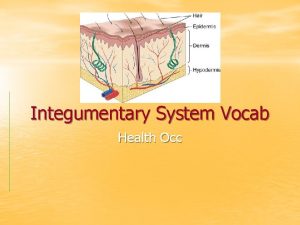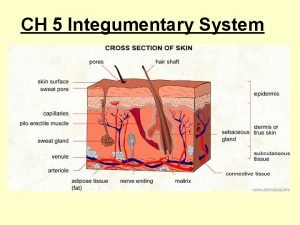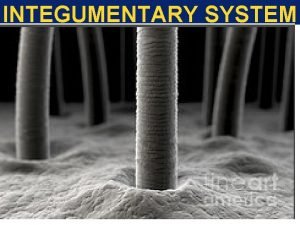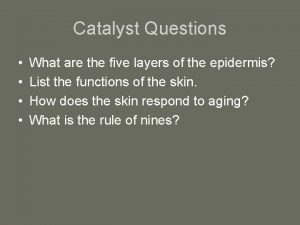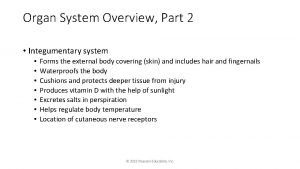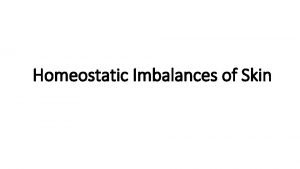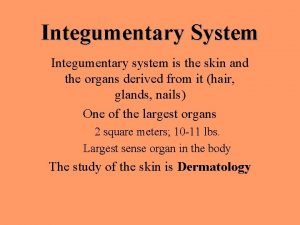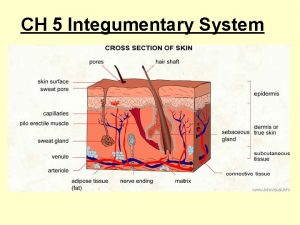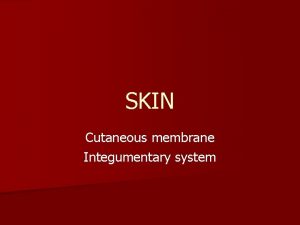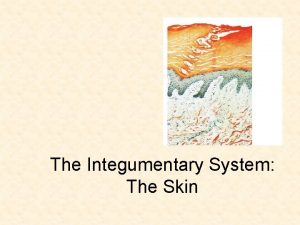The Integumentary System The Integumentary System n Skin





























- Slides: 29

The Integumentary System

The Integumentary System n Skin – our largest organ ¨ Accounts for 7% of body weight ¨ Divided into two distinct layers Epidermis n Dermis n ¨ Hypodermis – lies deep to the dermis

The Integumentary System n Functions ¨ Protection & Defense ¨ Thermoregulation ¨ Energy storage & synthesis ¨ sensory reception ¨ Excretion & Secretion

Skin Structure

Epidermis n Contains four main cell types ¨ Keratinocytes most abundant cell type in epidermis n Arise from deepest layer of epidermis n Produce keratin – a tough fibrous protein n Produce antibodies and enzymes n Keratinocytes are dead at skin's surface n ¨ Melanocytes – produce melanin ¨ Merkel cells – sensory ¨ Langerhans cells – defense cells

Layers of the Epidermis n n n Stratum basale (stratum geminativum) Stratum spinosum Stratum granulosum Stratum lucidum (only in thick skin, i. e. volar surfaces) Stratum corneum mnemonic device: Boys Spit Gross Luggies Constantly

Epidermal Cells and Layers of the Epidermis

Layers of the Epidermis n Stratum basale Deepest layer of epidermis ¨ Attached to underlying dermis ¨ Cells actively divide ¨ Stratum basale contains ¨ n Keratinocytes – most common cells in this layer ¨ n n n Manufacture (via sunlight conversion) vitamin D 3 Merkel cells – associated with sensory nerve ending Melanocytes – secrete the pigment melanin Stratum spinosum (spiny layer) "Spiny" appearance caused by artifacts of histological preparation ¨ Contains thick bundles of intermediate filaments (tonofilaments) ¨ Contains star-shaped Langerhans cells ¨

Layers of the Epidermis n Stratum granulosum ¨ Consists of keratinocytes and tonofilaments ¨ Tonofilaments contain Keratohyaline granules – help form keratin n Lamellated granules – contain a waterproofing glycolipid n n Stratum lucidum (clear layer) ¨ Occurs only in thick skin ¨ Composed of a few rows of flat, dead keratinocytes

Layers of the Epidermis n Stratum corneum (horny layer) ¨ Thick layer of dead keratinocytes and thickened plasma membranes ¨ Protects skin against abrasion and penetration

Dermis n n n Second major layer of the skin Strong, flexible connective tissue Richly supplied with blood vessels and nerves ¨ ¨ n Thermoregulation? Cyanosis? Has two layers Papillary layer – includes dermal papillae ¨ Reticular layer – deeper layer – 80% of thickness of dermis ¨

Sensory Structures of the Dermis Meissner’s Corpuscle n Pacinian Corpuscles n Hair root plexus n Free nerve endings n ¨ Pain & thermoregulation

Hypodermis Deep to the skin – also called superficial fascia n Contains areolar and adipose connective tissues n Anchors skin to underlying structures n Helps insulate the body n

Skin Color n Three pigments contribute to skin color ¨ Melanin – most important pigment – made from tyrosine ¨ Carotene – yellowish pigment from carrots and tomatoes ¨ Hemoglobin – Caucasian skin contains little melanin n Allows crimson color of blood to show through

Appendages of the Skin n Hair ¨ Flexible strand of dead, keratinized cells ¨ Hard keratin – tough and durable ¨ Chief parts of a hair Root – imbedded in the skin n Shaft – projects above skin's surface n

Appendages of the Skin n Hair – three concentric layers keratinized cells ¨ Medulla – central core ¨ Cortex – surrounds medulla ¨ Cuticle – outermost layer

Appendages of the Skin n Hair follicles – extend from epidermis into dermis ¨ Hair bulb – deep, expanded end of the hair follicle ¨ Root plexus – knot of sensory nerves around hair bulb

Appendages of the Skin n Wall of hair follicle ¨ Connective tissue root sheath ¨ Epithelial root sheath n Arrector pili muscle – bundle of smooth muscle ¨ Hair stands erect when arrector pili contracts

Types and Growth of Hair Vellus hairs – body hairs of women and children n Terminal hairs – hair of scalp; axillary and pubic area (at puberty) n Hair thinning and baldness n ¨ Due to aging ¨ Male pattern baldness

Sebaceous Glands n n Occur over entire body, except palms and soles Secrete sebum – an oily substance ¨ Simple alveolar glands ¨ Holocrine secretion – entire cell breaks up to form secretion n n Most are associated with a hair follicle Functions of sebum ¨ Collects dirt; softens and lubricates hair and skin

Sebaceous and Sweat Glands

Sweat Glands Sweat glands (sudoriferous/eccrine glands) are widely distributed on body n Sweat – is a blood filtrate n ¨ 99% water with some salts ¨ Contains traces of metabolic wastes

Sweat Glands n Two types of sweat gland ¨ Eccrine gland n Most numerous – produce true sweat (watery) n Coiled tubular gland n Controlled by the hypothalamus ¨ Apocrine gland n Confined to axillary, anal, and genital areas n Produce a fatty secretion of sweat during periods of stress/anxiety n Even though they are called apocrine sweat glands they do not secrete in an aprocrine fashion – rather in an eccrine or merocrine fashion as do the eccrine glands… the name has remained to avoid confusion of the two varieties of sweat glands!

Nails n Nails – scale-like modification of epidermis ¨ Made of hard keratin ¨ Parts of the nail Free edge n Body n Root n Nail folds n Eponychium n ¨ cuticle

Burns n Classified by severity ¨ First degree burn – only epidermis is damaged ¨ Second degree burn – upper part of dermis is also damaged Blisters appear n Skin heals with little scarring n ¨ Third degree burn – consume thickness of skin n Burned area appears white, red, or blackened

Skin Cancer Types n Basal cell carcinoma ¨ least malignant and most common ¨ appears as a round lump or flattened scaly area ¨ red, pale or pearly in color ¨ grows slowly, usually on the head, neck and upper torso ¨ untreated can cause disfiguration basal cell carcinoma extensive ulcerating basal cell carcinoma

Skin Cancer Types n Squamous cell carcinoma ¨ less common, but more dangerous than basal cell carcinoma ¨ not as dangerous as melanoma ¨ appears as a thickened, red, scaly spot that may bleed easily, crust or ulcerate ¨ appears on skin most often exposed to the sun ¨ grows over weeks to months and may spread to other parts of the body if not treated promptly

Skin Cancer Types n Melanoma – a cancer of melanocytes ¨ ¨ The most dangerous type of skin cancer The ABCD'S of Melanoma n n ¨ Men n ¨ Asymmetry-- One half doesn't match the other half. Border irregularity-- The edges are ragged, notched or blurred. Color-- The pigmentation is not uniform. Shades of tan, brown and black are present. Dashes of red, white and blue add to the mottled appearance. Diameter-- greater that six millimeters (about the size of a pencil eraser). Any growth of a mole should be of concern. Often on head, neck (upper body) or between shoulders & hips Women n Often shows up on the lower legs

The Skin Throughout Life At 5 -6 months, the fetus is covered with lanugo (downy hairs) n In middle to old age n ¨ Skin thins and becomes less elastic ¨ Shows harmful effects of environmental damage ¨ Skin inflammations become more common
 Stratum granulosum
Stratum granulosum Thin skin vs thick skin
Thin skin vs thick skin Milady facial massage steps
Milady facial massage steps Cutaneous membrane
Cutaneous membrane Integumentary system vocabulary
Integumentary system vocabulary Swine integumentary system
Swine integumentary system Definisi sistem integumen
Definisi sistem integumen The integumentary system facts
The integumentary system facts The integumentary system exercise 7
The integumentary system exercise 7 Integumentary system abbreviations
Integumentary system abbreviations Integument medical term
Integument medical term The integumentary system
The integumentary system Integumentary assessment
Integumentary assessment Excretory system analogy
Excretory system analogy Cat integumentary system
Cat integumentary system The integumentary system
The integumentary system Figure 5-1 the components of the integumentary system
Figure 5-1 the components of the integumentary system Integumentary system effects of aging
Integumentary system effects of aging Section 36-3 the integumentary system
Section 36-3 the integumentary system Integumentary system
Integumentary system Integumentary system
Integumentary system Unit 3 integumentary system a&p chapter 5
Unit 3 integumentary system a&p chapter 5 Skin homeostatic imbalance
Skin homeostatic imbalance Cells in stratum spinosum
Cells in stratum spinosum 6 functions of the integumentary system
6 functions of the integumentary system Skin cancer
Skin cancer Urinary system interesting facts
Urinary system interesting facts Integumentary system
Integumentary system Large organ of the body
Large organ of the body Integumentary system cpt coding guidelines ppt
Integumentary system cpt coding guidelines ppt









